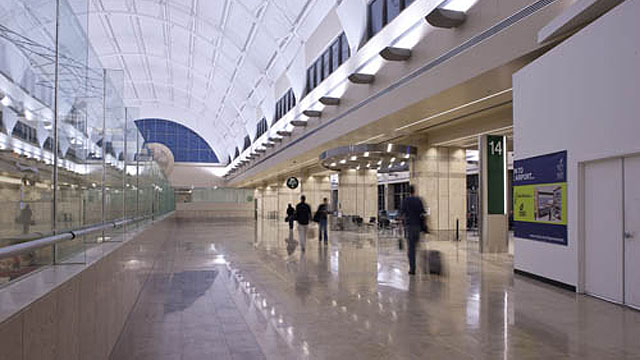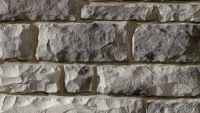December 19, 2011 2:45 PM CST
Serving as the general contractor, McCarthy began construction on Terminal C in August 2009. The project included adding a 282,000-square-foot, three-level terminal building plus a basement, to the existing 448,000 square feet in Terminals A and B at the Thomas F. Riley Terminal. McCarthy also performed upgrades and renovations to the existing terminals including the installation of a new paging/communications and information technology system in both terminals. The reconfiguration of three gates (two for international flights and one for the Common Use Passenger Processing System) as well as the remodel of select airline offices in Terminal B was also completed.
Terminal C features a total of six commercial passenger gates, two of which connect to Federal Inspection Services (FIS) (Customs) facilities for international flights and two new commuter terminals. Additional airport amenities include: five new passenger security screening checkpoints; new, easy-to-read flat screen monitors, featuring flight and baggage information for all airlines; three new baggage carousels; and a Common Use Passenger Processing System (CUPPS), one of the first universal check-in systems for printing boarding passes and checking bags at all 48 kiosks in the new Terminal and at a total of 142 kiosks throughout the airport once they are completed next year. Terminal C also boasts 23,000-square-feet of additional concession space, with nine new local and internationally known restaurants and retail stores.
“Our design at John Wayne Airport puts passengers first. We wanted to create a terminal that people intuitively understand, and that leverages the latest technology for the modern traveler,” says Keith Thompson, a Gensler Principal and leader of the firm’s global Aviation + Transportation practice area.
The design of Terminal C draws heavily from the distinctive features of the existing Riley Terminal, creating a seamless experience throughout the entire airport complex. The building’s exterior skin incorporates masonry, plaster, and stone along with glass and metal panels similar to the existing structures. The interior features barrel-vaulted ceilings resembling a fuselage, an abundance of windows and skylights, a soft, neutral color palette and natural marble limestone. Called Jura stone, the natural stone is featured throughout the walls and floors in all terminals. Its most distinguishing characteristic is the natural quartz veins and variable fossils which are visible on the beige background. The marble was mined in quarries inGermanyand cut, polished and fabricated inItaly, ensuring the correct color and precise and clean lines that make up this beautiful design treatment throughout the terminals.
For added passenger convenience, Terminal C is fitted with computer work stations and custom-designed power receptacles located between the backs of the passenger seating rows which allow travelers to charge their cell phones, laptops and other electronic devices while awaiting their flight. The airport installed similar power receptacles in Terminals A and B and offers free Wi-Fi throughout the facility.
McCarthy also coordinated the installation of a large scale three-dimensional sculpture above the baggage carousels in Terminal C. Created by artist Beth Nybeck ofKansas Cityin association with Dick Jobe, the sculpture is composed of 21 aluminum birds with wing spans ranging in size from three feet to 14 feet suspended on an “S” shaped structure. Created from aluminum and Plexiglas, the wings of the birds display enlarged portions of aeronautical charts rendered in multi-colored vinyl adhesive. Called “Flight of Ideas”, the piece was selected in a competitive process from more than 20 proposals submitted by artists across the country.
Further work by McCarthy included the construction of two new commuter terminals with space for up to three commuter/regional jets at the north end of Terminal A and three commuter/regional jets at the south end of Terminal C. All three terminals on both secure and non-secure sides are directly connected at Terminal B and Terminal C, providing access to a total of 20 gates via a single secure concourse.
“Building a major addition on a fully operational airport facility and coordinating with other ongoing airport improvement projects including a new parking structure and central utility plant required extensive planning and communication,” said Khatchig Tchapadarian, McCarthy’s project director for the airport project. “We phased construction and worked overnight shifts to ensure minimal impact to the passengers and airport operations. A barricade was also installed between Terminal B and C, and the construction team worked closely with airport operations to coordinate construction access, deliveries and cranes.”
Tchapadarian explained that one of the project’s most unusual and complex features was installing the barrel-vaulted roof on the Terminal C concourse. “The standing-seam metal roof, which is sandwiched by other structures at both ends, measure 60 feet-high and is designed on a 33° degree radius,” said Tchapadarian. “We devised a solution which uses expansion joints enabling the roof to move between the existing concourse and the new terminal to accommodate for any seismic activity or thermal expansion.” Approximately 26 construction workers completed the roof installation by first pouring 1,080 cubic yards of light weight insulating concrete then carefully installing approximately 2,100 metal roof panels. Much of the work was conducted atop the 60-foot high structure, and the process took six months to complete.
In order to reduce errors in the field, Building Information Modeling (BIM) was used to create a 3D model of the project before construction began. The virtual model helped to detect and avoid any system clashes in advance of construction which in turn reduced construction duration and improved the quality of construction. The project was designed in Revit, and NavisWorks was used for clash detection.
Terminal C also features sustainable elements including an innovative LED lighting system which provides consistent lighting throughout the terminal. The system requires little or no maintenance for 20 years, and will decrease the energy it consumes by at least 37%. Furthermore Terminal C’s Water Quality Management Plan incorporates environmental controls and specifies the means and methods of pollution control. Environmentally responsible construction was used during the project including: curbing storm water runoff from the construction sites to prevent discharge of pollutants to the storm drains; recycling 90 percent of construction-related materials and waste; and dust mitigation activities to minimize air quality effects during construction.
“Visitors to John Wayne Airport will experience a near seamless transition between all three terminals—a key objective in McCarthy’s construction of Terminal C and in improvements made to Terminals A an B in the Thomas F. Riley Terminal,” said Airport Director Alan L. Murphy,. “The extensive use of marble throughout the lobbies and concourse, the floor to ceiling windows, along with all new LED lighting and technological advancements throughout the terminal, provides an innovative yet familiar travel experience.”
Parsons of Pasadena, Calif. is the Program Manager; Arcadis/Pinnacle One of Irvine, Calif. is the Construction Management firm; Jacobs of Santa Ana, Calif. is the Civil & MEP Engineer; and IDS Group, Inc. ofIrvine,Calif.is the Structural Engineer. The main specialty contractors are: Capparelli/KHS&S ofOrange(framing/drywall); Helix of San Diego, Calif. (electrical), A.O. Reed of San Diego (HVAC) and Pan Pacific Plumbing ofIrvine(plumbing).
Marble limestone shines in John Wayne Airport Terminal
Natural stone is featured throughout all terminals
By McCarthy Building Companies, Inc.

Jura stone is featured throughout the walls and floors in all terminals.
JohnWayneAirport’s (JWA’s) new Terminal C opened to passengers on November 14, 2011. Constructed by McCarthy and designed by Gensler, the new terminal increases JWA’s capacity from 8.4 million annual passengers to 10.8 million. It also provides the airport with the ability to operate international flights. The $211.5 million facility was part of the $543 million Airport Improvement Program (AIP) – one of Orange County, Calif.’s largest-ever public works programs – which created approximately 6,670 jobs over the life of the project.Serving as the general contractor, McCarthy began construction on Terminal C in August 2009. The project included adding a 282,000-square-foot, three-level terminal building plus a basement, to the existing 448,000 square feet in Terminals A and B at the Thomas F. Riley Terminal. McCarthy also performed upgrades and renovations to the existing terminals including the installation of a new paging/communications and information technology system in both terminals. The reconfiguration of three gates (two for international flights and one for the Common Use Passenger Processing System) as well as the remodel of select airline offices in Terminal B was also completed.
Terminal C features a total of six commercial passenger gates, two of which connect to Federal Inspection Services (FIS) (Customs) facilities for international flights and two new commuter terminals. Additional airport amenities include: five new passenger security screening checkpoints; new, easy-to-read flat screen monitors, featuring flight and baggage information for all airlines; three new baggage carousels; and a Common Use Passenger Processing System (CUPPS), one of the first universal check-in systems for printing boarding passes and checking bags at all 48 kiosks in the new Terminal and at a total of 142 kiosks throughout the airport once they are completed next year. Terminal C also boasts 23,000-square-feet of additional concession space, with nine new local and internationally known restaurants and retail stores.
“Our design at John Wayne Airport puts passengers first. We wanted to create a terminal that people intuitively understand, and that leverages the latest technology for the modern traveler,” says Keith Thompson, a Gensler Principal and leader of the firm’s global Aviation + Transportation practice area.
The design of Terminal C draws heavily from the distinctive features of the existing Riley Terminal, creating a seamless experience throughout the entire airport complex. The building’s exterior skin incorporates masonry, plaster, and stone along with glass and metal panels similar to the existing structures. The interior features barrel-vaulted ceilings resembling a fuselage, an abundance of windows and skylights, a soft, neutral color palette and natural marble limestone. Called Jura stone, the natural stone is featured throughout the walls and floors in all terminals. Its most distinguishing characteristic is the natural quartz veins and variable fossils which are visible on the beige background. The marble was mined in quarries inGermanyand cut, polished and fabricated inItaly, ensuring the correct color and precise and clean lines that make up this beautiful design treatment throughout the terminals.
For added passenger convenience, Terminal C is fitted with computer work stations and custom-designed power receptacles located between the backs of the passenger seating rows which allow travelers to charge their cell phones, laptops and other electronic devices while awaiting their flight. The airport installed similar power receptacles in Terminals A and B and offers free Wi-Fi throughout the facility.
McCarthy also coordinated the installation of a large scale three-dimensional sculpture above the baggage carousels in Terminal C. Created by artist Beth Nybeck ofKansas Cityin association with Dick Jobe, the sculpture is composed of 21 aluminum birds with wing spans ranging in size from three feet to 14 feet suspended on an “S” shaped structure. Created from aluminum and Plexiglas, the wings of the birds display enlarged portions of aeronautical charts rendered in multi-colored vinyl adhesive. Called “Flight of Ideas”, the piece was selected in a competitive process from more than 20 proposals submitted by artists across the country.
Further work by McCarthy included the construction of two new commuter terminals with space for up to three commuter/regional jets at the north end of Terminal A and three commuter/regional jets at the south end of Terminal C. All three terminals on both secure and non-secure sides are directly connected at Terminal B and Terminal C, providing access to a total of 20 gates via a single secure concourse.
“Building a major addition on a fully operational airport facility and coordinating with other ongoing airport improvement projects including a new parking structure and central utility plant required extensive planning and communication,” said Khatchig Tchapadarian, McCarthy’s project director for the airport project. “We phased construction and worked overnight shifts to ensure minimal impact to the passengers and airport operations. A barricade was also installed between Terminal B and C, and the construction team worked closely with airport operations to coordinate construction access, deliveries and cranes.”
Tchapadarian explained that one of the project’s most unusual and complex features was installing the barrel-vaulted roof on the Terminal C concourse. “The standing-seam metal roof, which is sandwiched by other structures at both ends, measure 60 feet-high and is designed on a 33° degree radius,” said Tchapadarian. “We devised a solution which uses expansion joints enabling the roof to move between the existing concourse and the new terminal to accommodate for any seismic activity or thermal expansion.” Approximately 26 construction workers completed the roof installation by first pouring 1,080 cubic yards of light weight insulating concrete then carefully installing approximately 2,100 metal roof panels. Much of the work was conducted atop the 60-foot high structure, and the process took six months to complete.
In order to reduce errors in the field, Building Information Modeling (BIM) was used to create a 3D model of the project before construction began. The virtual model helped to detect and avoid any system clashes in advance of construction which in turn reduced construction duration and improved the quality of construction. The project was designed in Revit, and NavisWorks was used for clash detection.
Terminal C also features sustainable elements including an innovative LED lighting system which provides consistent lighting throughout the terminal. The system requires little or no maintenance for 20 years, and will decrease the energy it consumes by at least 37%. Furthermore Terminal C’s Water Quality Management Plan incorporates environmental controls and specifies the means and methods of pollution control. Environmentally responsible construction was used during the project including: curbing storm water runoff from the construction sites to prevent discharge of pollutants to the storm drains; recycling 90 percent of construction-related materials and waste; and dust mitigation activities to minimize air quality effects during construction.
“Visitors to John Wayne Airport will experience a near seamless transition between all three terminals—a key objective in McCarthy’s construction of Terminal C and in improvements made to Terminals A an B in the Thomas F. Riley Terminal,” said Airport Director Alan L. Murphy,. “The extensive use of marble throughout the lobbies and concourse, the floor to ceiling windows, along with all new LED lighting and technological advancements throughout the terminal, provides an innovative yet familiar travel experience.”
Parsons of Pasadena, Calif. is the Program Manager; Arcadis/Pinnacle One of Irvine, Calif. is the Construction Management firm; Jacobs of Santa Ana, Calif. is the Civil & MEP Engineer; and IDS Group, Inc. ofIrvine,Calif.is the Structural Engineer. The main specialty contractors are: Capparelli/KHS&S ofOrange(framing/drywall); Helix of San Diego, Calif. (electrical), A.O. Reed of San Diego (HVAC) and Pan Pacific Plumbing ofIrvine(plumbing).
About the Author
McCarthy Building Companies, Inc. is one of the nation’s largest domestic general contractors. More information about the company is available online at www.mccarthy.com.


















